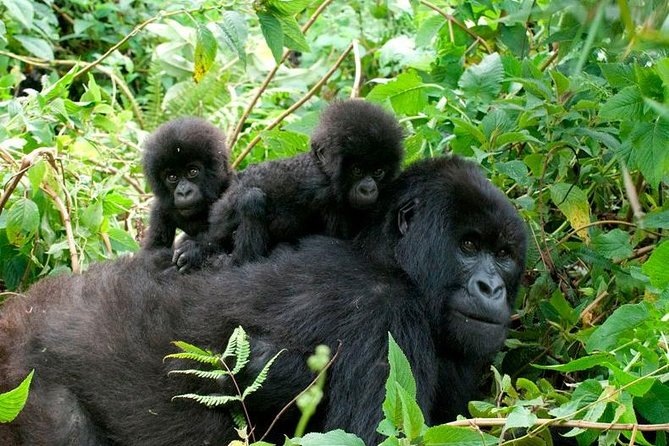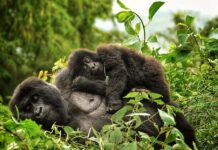Bwindi Impenetrable National Park. Bwindi Impenetrable National Park is world-renowned for its mountain gorillas and the gorilla trekking adventure that feeds tourists with everlasting memories.
With over half of the world’s population of mountain gorillas living in this UNESCO World Heritage site, this park offers the rare opportunity to trek and observe these magnificent creatures in their natural habitat. The trek can be strenuous but an unforgettable experience. Engaging in trekking activity, one should be physically fit.
The park offers intriguing feelings to visitors with its historical mountain gorillas but it offers a variety of magical forms and colors of other primates that are exquisitely interesting to tourists.
These impenetrable high thick trees that gang up to make a forest are sacred to prominent primates like chimpanzees, baboons, blue monkeys, red-tailed monkeys, black and white colobus monkeys among others.
A collection of water sources as well as thick and towering trees definitely attracts all kinds of bird species. With the presence of River Ivy in the park, more than 346 bird species storm the park with over 90% of them being endemic to the Albertine Rift.
Species like a strange weaver, red-fronted and peckers, strange weaver, regal sunbird, Rwenzori batis will entertain visitors with various colors and their chirping sounds and interesting voices produced.
The park obtained its Impenetrable name from the thick shrubs and vines that cover the landscape of the park. The medium and high elevations of the park thrive through mixed forests that include Newtonia, red stinkwood, and East African yellow wood, and the low areas survive on parinari, African mahogany, and the Newtonia buchachanii.
The park harbors over 600 individuals divided into 50 gorilla families and 13 individuals who prefer being loners in the vastness of the park. 21 families are habituated and can be accessed through the four trekking regions of Buhoma, Rushaga, Nkuringo and Ruhija.
Queen Elizabeth National Park. Queen Elizabeth National Park is one of the top visited savanna parks in Uganda and a perfect location to find the tree climbing lions in the Ishasha sector.
Located in western Uganda, Queen Elizabeth National Park is a prime destination for wildlife viewing. The park boasts a wide variety of animals including lions, elephants, buffalo among others as well as over 600 species of birds. Visitors can take boat safaris on the Kazinga Channel which is teeming with hippos, crocodiles and various bird species.
Murchison Falls National Park. Murchison Falls National Park is Uganda’s largest national park known for its impressive Murchison Falls where the Nile River crashes through a narrow gap in the rocks. The park is rich in wildlife with elephants, giraffes, lions, leopards among others roaming freely. The river safaris along the Nile offer great opportunities for close-up views of wildlife like hippos and crocodiles.
About 4 protected areas are encompassed within the greater Murchison Falls Conservation Area that’s Murchison Falls National Park, Budongo Forest, Karuma Wildlife Reserve and Bugungu Wildlife Reserve.
Murchison Falls National Park gets its name from the Murchison Falls. This is a natural wonder that makes this park one of the most sought-after destinations in Uganda and East Africa at large. It is at this waterfall where the mighty Nile River is observed exploding through a narrow rock of about 8m before it flows to the Albertine Nile.
Murchison Falls National Park is largely comprised of savanna grassland, wetlands, riverine woodland, Borassus palms, tropical forest and acacia trees. It is the loveliest spot for big game safaris in Uganda. Murchison Falls National Park protects variety of the most sought-for wildlife on an African safari.
Over 76 mammal species, plus many reptiles all live in this park. Only 4 of the big 5 game call Murchison Falls National Park a home and they include lions, leopards, buffaloes and elephants. These share the same habitat with a range of other species: the Rothschild giraffes, Nile crocodiles, hippos, warthogs, oribis, waterbucks, the grey duikers, Uganda Kobs among others.
Over 800 chimpanzees reside in the Kaniyo-Pabidi and Budongo Forests together with plenty of playful olive baboons, the red-tailed monkeys, blue monkeys, black and white colobus monkeys.
Over 451 bird species await you to explore on birding tour in Murchison Falls National Park. The birds in this park include; Abidin stork, black headed lapwing, malachite kingfisher, black headed gonoleks, eastern grey plantain eaters, palm nut vultures, blue headed coucal, piapiac, red throated bee-eaters, shoebill stork, white-browed sparrow weaver among others.
Kibale National Park. Kibale is one of the best places in the world for chimpanzee trekking. With over 1,500 chimpanzees living in the park, visitors can embark on guided treks to observe these fascinating primates in their natural forest environment. This beautiful primate safari park was gazetted in 1993 and covers the land area of about 795sq.kms. It is largely comprised of a lush tropical forest and lies between altitude 1100 and 1590m.
A part from Chimpanzees, other primates in Kibale include; the endangered red colobus monkeys, red-tailed monkeys, vervet monkeys, olive baboons, blue monkeys, black and white colobus monkeys, pottos, bush babies, mangabeys among others.
Wildlife in in Kibale Forest include; duikers, bush pigs, leopards, elephants, buffaloes, reptiles, amphibians and more than 200 butterfly species. A total of about 351 species of trees have also been recorded in Kibale National Park alone and most of them are of research purposes.
Kibale National Park is also a valuable habitat to a range of birdlife. Over 375 bird species have been registered in Kibale alone and they include 4 native species of birds: the masked apalis, blue headed bee-eaters, Cassin’s Spinetail and Nahan’s Francolin.
Other Kibale bird species check-list include the African green breasted pitta, blue breasted kingfishers, collared apalis, black capped apalis, crowned eagles, Abyssinian ground thrush, little greenbul, yellow rumped tinkerbird, black eared ground thrush, yellow spotted nicator, purple breasted sunbird, dusky crimson wings, Cameroon sombre greenbul, black billed turacos, African wood owl, African black headed oriole, African green pigeon, papyrus canary, brown eared woodpecker, ash flycatcher, African emerald cuckoo and more. Kibale Forest National Park is situated in an area with several Crater Lakes in the surrounding such as Lake Nyinabulitwa, Lake Nyinabuga, Lake Nyabikere, Lake Nkuruba and others. Chimpanzee trekking is the main highlight of all visits to Kibale National Park, Uganda.
Lake Mburo National Park. Located just a few hours from Kampala, Lake Mburo National Park is one of Uganda’s smallest national parks but offers a unique safari experience with walking safaris. The park is home to zebras, impalas, buffaloes, elands and various antelope species. Lake Mburo is also an excellent spot for boat safaris and bird watching as it is home to over 350 bird species.
Lake Mburo National Park has five lakes that are found within the premises of the park. The famous being Lake Mburo, other water catchment areas in the park include Lake Kigambira among others. The woody vegetation of Lake Mburo National Park spiced up by olea, Boscia and Acacia are a haven of wildlife considering the various herbivores that depend on it for their existence. Though this park is small but a lot of activities can be done while you are in the park such as game drives, boat cruise, game walking tours, bird watching, sport fishing, horseback riding, cycling among other activities.
Kidepo Valley National Park. Kidepo Valley National Park is situated in the North Eastern part of Uganda. It is quietly perched in the outlying areas towards the Ugandan border with the Republic of South Sudan and Kenya. The Park is situated in the infamous Karamoja region covered by savannah vegetation given the regional semi-arid climate. The park’s significant features include Narus River Valley, and the Kidepo Valley. These valleys are extensive and because of this, the park’s name is complete.
Kidepo Valley National Park’s attractions range from fauna, flora, geophysical landscape and related features. Fauna present is composed of over 80 mammal species with all major species of animals such as lions, elephants, African buffaloes, spotted hyenas, leopards, giraffes, zebras, cheetahs, and many more. Flora covers the Narus River valley. Most of the flora is composed of short grassland ranging from fine thatching grass, bunchy Guinea grass and red oat grass.
Kidepo Valley National Park is located in a very strategic corner which is a good home for numerous migratory bird species. About 450 bird species are situated in the park. These birds are both from within Uganda and migratory birds from other countries. More than 40 bird species in the park are endemic to the Karamoja region such as the Karamoja Apalis. Some of the famous birds are ostriches which are fan to watch as they run within the park. Others include the Egyptian vultures, Abyssinian roller, Pygmy falcon, eagles, Kori bustard among others.
Along the towering Mountain Morungole, there is IK tribe. They are an indigenous tribe to the area who have lived on Kidepo lands for many generations. They have been registered and known commonly for their food gathering and prowess in hunting. These good people are also lovers of honey and therefore are preoccupied with apiary as one of their agricultural practices.
Their culture is beautiful to experience as they are among the few tribes within the East Africa region who still live an extensive African traditional lifestyle.
Mgahinga National Park. Mgahinga is the only park in the country that is part of the Virunga massif. This park possesses up to three mountains that are part of the eight Virunga volcanoes.
Mgahinga National Park is the smallest of the ten National Park that make Uganda a complete travel destination. The Park occupies a compact land area measuring up to only 33sq.kms and lying at elevation of 4127m.
Gorilla trekking in Mgahinga National Park is a lifetime opportunity to get up close and personal with the massive silverback gorilla and its members while in their natural habitat. Mgahinga National Park is a habitat to only 1 habituated family Nyakagezi.
Source of River Nile. This prestigious river flows through different countries before finally pouring its waters into the Mediterranean Sea. Tourists have to come all the way to Jinja, the Eastern part of Uganda to sight the start of the longest river in the world.
Amabere ga nyina mwiru. Culturally, this site is connected to the Bachwezi and specifically to King Bukuku and his daughter Nyina Mwiru. It is believed that Bukuku’s daughter lost her breasts after they were cut off and there are many theories that explain why she lost them. Geographers states it out that these caves were formed as a result of stalactites and stalagmite rocks.
Whether cultural or geographical, tourists enjoy visiting the site and get a glimpse of Amabere ga nyina mwiru because the site has rocks curved like breasts and it’s fascinating to watch leaving one no choice but to think through the cultural point of its existence. This cultural attraction is located in fort portal and can be visited as your heading to Kibale National Park.
Nyero rock painting. These artistic rocks are found in Kumi District in the Eastern part of Uganda and are believed to have been sacred places for gods. Itesots previously would make sacrifices and pay offerings to their gods concerning their problems like praying for rain but they were stopped by the government such that they can gazette the site since it was added among the UNESCO world heritage sites in 1997.






